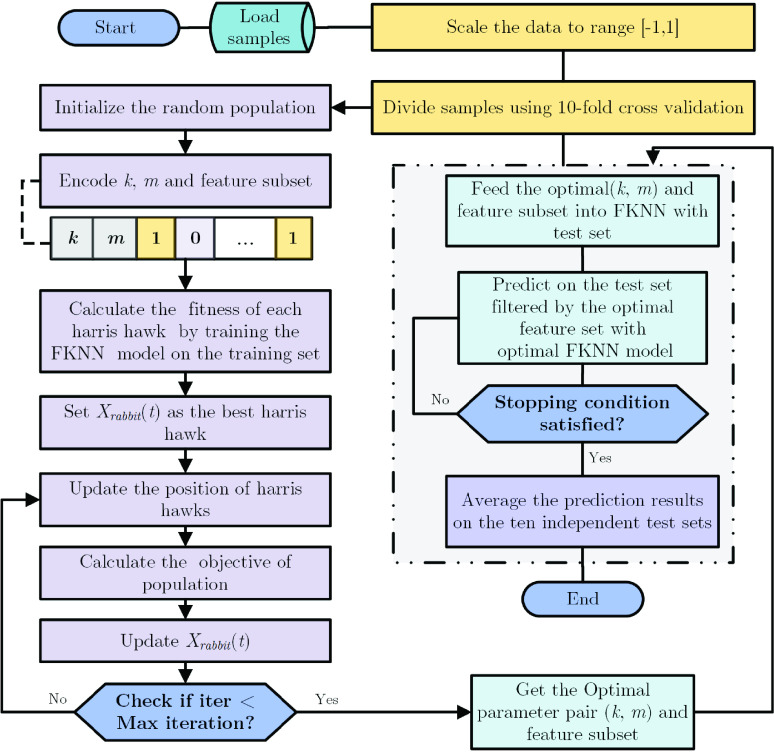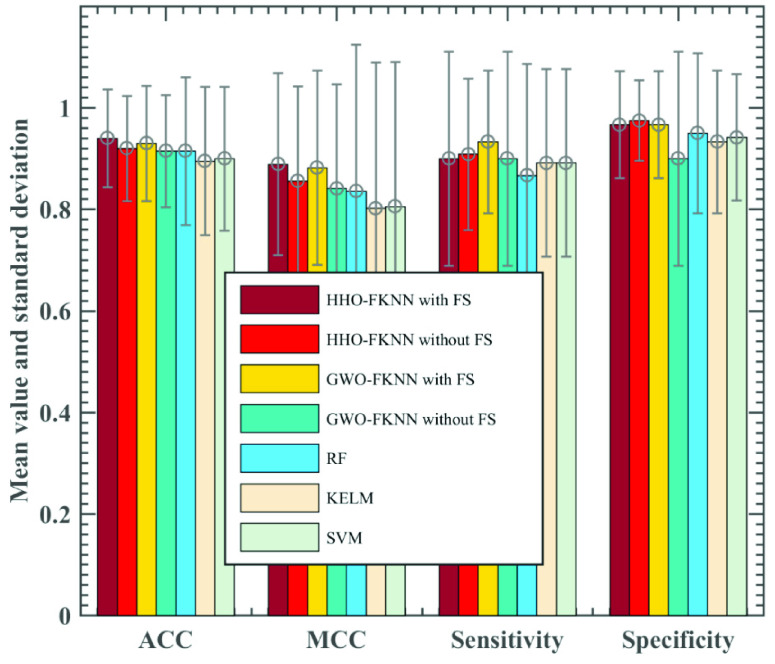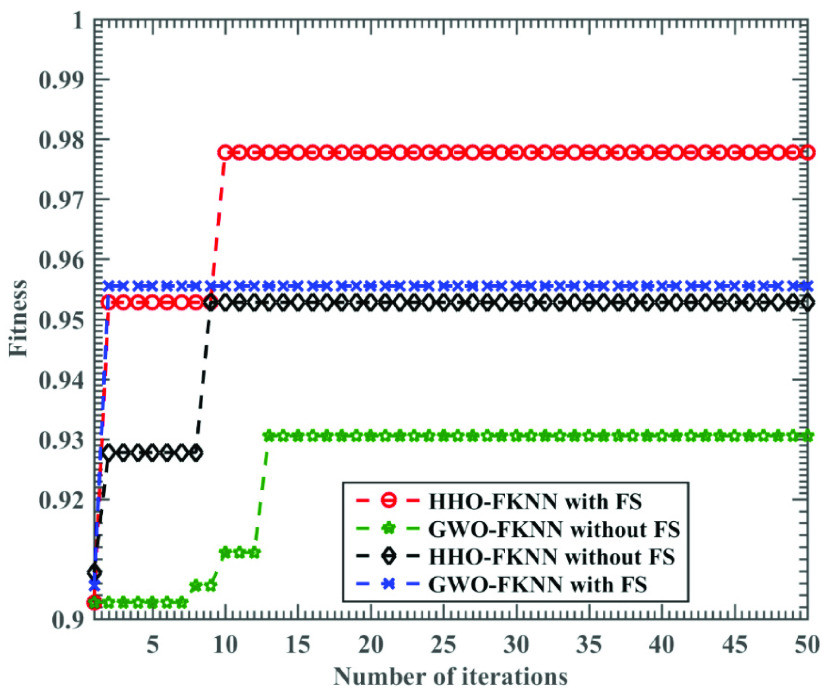Abstract
This study is devoted to proposing a useful intelligent prediction model to distinguish the severity of COVID-19, to provide a more fair and reasonable reference for assisting clinical diagnostic decision-making. Based on patients’ necessary information, pre-existing diseases, symptoms, immune indexes, and complications, this article proposes a prediction model using the Harris hawks optimization (HHO) to optimize the Fuzzy K-nearest neighbor (FKNN), which is called HHO-FKNN. This model is utilized to distinguish the severity of COVID-19. In HHO-FKNN, the purpose of introducing HHO is to optimize the FKNN’s optimal parameters and feature subsets simultaneously. Also, based on actual COVID-19 data, we conducted a comparative experiment between HHO-FKNN and several well-known machine learning algorithms, which result shows that not only the proposed HHO-FKNN can obtain better classification performance and higher stability on the four indexes but also screen out the key features that distinguish severe COVID-19 from mild COVID-19. Therefore, we can conclude that the proposed HHO-FKNN model is expected to become a useful tool for COVID-19 prediction.
Keywords: COVID-19, coronavirus, fuzzy K-nearest neighbor, Harris hawk optimization, disease diagnosis, feature selection
I. Introduction
Coronavirus disease 2019 (COVID-19) is a highly contagious viral disease, and the World Health Organization (WHO) declared that the COVID-19 was an international public health emergency [1], [2]. First described COVID-19 in December 2019 in Wuhan, Hubei Province, China. The ongoing outbreak of COVID-19 is affecting multiple countries in the world [1]. Until Mar 11th, 2020, 118,326 cases of COVID-19 were diagnosed worldwide, including 80,955 cases in China and 37,371 cases outside China. Additionally, 4,292 deaths have been triggered by COVID-19 [3]. Many countries are facing increased pressures on health care resources. Up to now, a great deal of studies is focused on using traditional statistical methods to identify risk factors of COVID-19 patients. As an example, older age, pre-existing diseases, abnormal liver function, and T-lymphocyte count were correlated closely with COVID-19 progression and prognosis [4]–[6]. However, traditional statistical methods could not rapidly identify changes in COVID-19 patient’s status during the outbreak. Therefore, there is a crucial need to progress a useful forecasting tool for COVID-19 and quickly categorize illness severity.
Currently, the importance of computational, mathematical, and surveillance-based methods for the study of infectious diseases continues to increase [7]. Machine learning-based methods are increasingly being used to diagnose disease, develop prediction models, and identify risk factors [8]. The benefits of machine learning include improving health professionals’ ability to establish diagnosis or prognosis; it will replace much of the work of radiologists and anatomic/clinical pathologists; it will improve the accuracy of diagnosis [9]. Therefore, machine learning is an indispensable tool for clinicians seeking to understand patient-individualized treatment better. We use a machine learning strategy to identify COVID-19 patients at high risk for severe illness and prioritize their hospitalization. It may contribute to reduce patient mortality and reduce the burden on healthcare resources.
Optimization depends on the form of the problem we deal with. It is almost possible to reach any form according to the decision-makers preferences. These problems can be modeled as many-objective [10], [11], memetic [12], robust [13], multiobjective [14], large scale [15], [16], fuzzy [17], and single-objective optimization. These forms and the growing demand for their solvers have raised many challenges in data science. Core problems demanding optimization are not limited to healthcare systems, but technologies such as the neural networks [18], water-energy optimization [19], image boost optimization [20], decision-making systems [21]–[23], temperature optimization [24], deployment optimization in sensor networks [25], sustainable development [26]–[28], parameter optimization [29], optimal resource allocation [30], deep learning tasks [31]–[33], mechanical parameters optimization [34], and many other potentials and connected domains [35]–[39]. One of the main classes are solvers with an evolutionary basis. This optimization algorithm works based on an evolving swarm with stochastic updating rules. They have found a good application effect in many scenarios [40]–[45]. At present, as a new single-objective algorithm, Harris Hawks Optimizer (HHO)1 has been widely concerned like other optimizers and their applications such as Particle Swarm Optimizer (PSO) [46], [47], Whale Optimizer (WOA) [48], Differential Search (DS) [49], Differential Evolution (DE) [50], Slime Mould Algorithm (SMA)2 [51], Monarch Butterfly Optimization (MBO) [52], and Moth Search Algorithm (MSA) [53].
HHO not only has strong plasticity but also has been widely used in other fields. Many HHO variants have been proposed recently [54]–[57]. Elaziz et al. [58] proposed an improved Harris-Hawks Optimizer (HHO) to solve a multilevel image segmentation problem’s global optimization problem and determine the optimal threshold. A large number of results and comparisons show that SSA has a strong ability to improve HHO. Gupta et al. [59] put four effective strategies into the traditional HHO, such as putting forward a nonlinear prey energy parameter, different fast diving, greedy selection mechanism, and learning based on opposites. Experimental results show that the proposed m-HHO can be a useful optimization tool for solving global optimization problems. Shao, Shao et al. [60] proposed a new rolling bearing fault diagnosis method based on variational mode decomposition (VMD), time-shifting multiscale discrete entropy (TSMDE), and support vector machine (SVM) optimized by vibration Harris Hawks Optimization algorithm. The outcomes show that this routine has better diagnostic performance than other comparison methods. Tikhamarine et al. [61] Combined multi-layer perceptron (MLP) neural network and least squares support vector machine (LSSVM) data-driven technology with advanced natural heuristic optimizer (HHO) to simulate rainfall-runoff relationship. The experimental results show that the mixture of HHO and LSSVM can obtain high accuracy of runoff prediction.
Machine learning is widely used in the medical field. For example, Abbasi et al. [62] proposed a new method for solving large-scale stochastic operation optimization problems (SOPs) using a machine learning model and applying the proposed decision-making method of blood unit transportation in the hospital network. The results show that compared with the current strategy, the average daily cost is reduced by 29% with the trained neural network model. In comparison, the average daily cost can be reduced by 37% with the proper optimal strategy. Amiri et al. [63] used photonic crystal structure and machine learning technology to calculate the concentration of potassium chloride, urea, and glucose (PUG) in human blood to achieve accurate measurement. Moreover, at this article’s finale, a mathematical model is revealed to obtain the output power and potassium chloride changes, urea, and glucose concentrations. Ayyıldız and Arslan Tuncer [64] used red blood cell index and machine learning technology, including support vector machine (SVM) and k-nearest neighbor (KNN), to differentiate IDA from Î - thalassemia. Instead, it employs the neighborhood component analysis feature selection (NCA) technique to select the dataset’s features. Their obtained results point to that the RBC indices can result in higher efficacy than those described in the other works. Banerjee et al. [65] used machine learning (ML), artificial neural network (ANN) [18], and a humble statistical test to recognize sars-cov-2 positive patients. This new method can significantly improve initial screening for patients with limited PCR based diagnostic tools. Rammurthy and Mahesh [66] designed the wHHO by combining whale optimization algorithm (WOA) with HHO. They applied it to the tumor automatic classification model. Experiments show that the method of deep CNN based on WHHO is better than other methods.
This study aims to develop efficient frameworks using the Harris hawk’s optimizer (HHO), which trains a fuzzy k-nearest neighbor (FKNN) model. Then, the optimized HHO-FKNN is substantiated for the first time to diagnose the severity of COVID-19. The active model is built using the info about patients’ necessary information, pre-existing diseases, symptoms, immune indexes, and complications. In the developed method (HHO-FKNN), HHO was employed to train an FKNN model and to explore the critical risk factors of COVID-19 infected people at the same time. In the experiment, HHO-FKNN is compared with the other machine learning methods like grey wolf optimizer (GWO)-based FKNN (GWO-FKNN), support vector machines (SVM), and random forest (RF). It is shown that the established HHO-FKNN method performs much better than its peers in terms of four evaluation metrics, including the classification accuracy (ACC), sensitivity, specificity, and Matthews Correlation Coefficients (MCC). Hence, the main contributions of this study can be listed as follows:
-
(a)
The well-established HHO was successfully applied to tackle the parameter tuning and feature selection for FKNN.
-
(b)
The proposed HHO-FKNN is employed for the diagnosis of the severity of COVID-19 for the first time.
-
(c)
It is the first time to diagnose the severity of COVID-19 based on an immune index.
-
(d)
The established HHO-FKNN model outperforms other evolutionary-based competitors.
The structure of this article is as bellow. Section 2 described the data and proposed the HHO-FKNN model in detail. The experimental arrangement and marks are explained in Section 3. Section 4 presents the discussions. The conclusions and upcoming works are presented in Section 5.
II. HHO-FKNN Method
The flowchart of HHO-FKNN is exposed in Figure 1. The whole procedure comprises data acquisition, standardization, feature selection, and classification. The first phase is to normalize the records, then using the HHO approach to select the informative features from the data samples and optimize the two critical parameters of the FKNN model. Then the FKNN classifier is trained again by using the optimal parameters and feature subset. Finally, the optimal FKNN classifier is taken to determine whether the specific patient is severe or non-severe. The commonly used 10-fold cross-validation (CV) scheme is used to divide the data and obtain more accurate and unbiased experimental results, often adopted by many studies [67]–[74].
FIGURE 1.
Flowchart of HHO-FKNN.
A. Parameter Optimization and Feature Selection by HHO
Healthcare and diagnosis systems have many hardware and software aspects considered and modeled [75], [76]. Any inaccuracy in the diagnosis can lead to a crisis [77]. This research focuses on developing a hybrid HHO-FKNN prediction core to be utilized for diagnostic purposes. In this model, the feature selection core utilizes a binary model of HHO. As we know, the primary method of HHO is a continuous approach verified on a set of problems with no binary variable. HHO was invented by Heidari et al. [78] as a new swarm-based algorithm for solving a set of unconstrained or even constrained cases. This method also has its exclusive features based on hawks and rabbits’ greedy actions in wildlife [79]. This method found its widespread applications in dealing with different problems [80]–[82].
This research deals with a feature selection problem that inherits both continuous and binary optimization aspects. From the other side, we know the initial HHO is not compatible with binary spaces. However, we need to optimize both types of variables. Thus, we aim to advance the hybrid HHO by combining the continuous variant and the binary type to optimize any parameters.
B. Classification Based on FKNN
FKNN is used as a core prediction engine, which is used to perform classification tasks after obtaining the optimal parameters and feature subset. FKNN [83], [84] classifier is developed based on the traditional k-nearest neighbor (KNN) classifier and has been widely considered from the time when it was initially suggested [85], [86], [86]–[88]. Compared with procedures such as extreme learning machines [89]–[94], deep learning methods [95]–[97], and support vector machines [70], [17], [98]–[103], FKNN is much simpler and can return outcomes that can be more easily understood.
Up to now, FKNN presented its capacity as a unique aspect of neighbor classification and case-based learning [104]. It is one of the most significant characteristics of FKNN to represent inaccurate information and provide samples belonging to related categories. After being allocated a membership, we can classify each sample into a class with the highest membership value. Many works utilized FKNN because of its competitive advantages. For examples, it found its application in various scenarios, including slope collapse prediction scenarios [105], protein identification and prediction scenarios [106], [107], medical diagnosis cases [87], [108], bankruptcy prediction models [86], and grouting activity prediction scenarios [109]. Logically, there is no perfect model and method in the artificial intelligence area. For instance, FKNN suffers from some issues; one of them is its dependency on two key parameters, the fuzzy intensity factor ( and the number of neighbors (
and the number of neighbors ( . Therefore, these two limits have to be adjusted correctly to attain a superior classification efficacy. In this research, we employed the HHO to adjust the parameters of FKNN.
. Therefore, these two limits have to be adjusted correctly to attain a superior classification efficacy. In this research, we employed the HHO to adjust the parameters of FKNN.
To implement the fuzzy  -NN system, we follow the next operations:
-NN system, we follow the next operations:
-
Step 1:Consider
to be the reference set we have at hand and
be a set of
 -dimensional vectors.
-dimensional vectors. -
Step 2:
For every
 ,
,  ,
,  , and
, and  denotes the number of classes.
denotes the number of classes. -
Step 3:For each
 that we want to classify, we can attain the set
that we want to classify, we can attain the set  of indices that correspond with the “
of indices that correspond with the “ nearest neighbors of
nearest neighbors of  in
in  and the fuzzy decision-vector” [83].
and the fuzzy decision-vector” [83].
-
Step 4:
If the user is involved in a non-fuzzy decision, ties are wrecked randomly or by the single NN law. If all
 ,
,  ,
,  , are equivalent to 0 or 1, then we can consider the fuzzy
, are equivalent to 0 or 1, then we can consider the fuzzy  -NN instruction equivalents to the normal
-NN instruction equivalents to the normal  -NN rule.
-NN rule.
C. Proposed HHO-FKNN
To utilize and explore the potential of KNN, its parameters are optimized and adjusted using the HHO. It is also appointed to determine the optimal feature subsets in the datasets. Here, we describe the main steps of feature selection and parameter optimization of the proposed HHO-FKNN model:
-
Step 1:
Load samples and scale the data.
-
Step 2:
Divide samples using 10-fold cross-validation.
-
Step 3:
Initialize the input parameters of HHO. These parameters are population, population size, bounds, space dimension, and numbers of iterations.
-
Step 4:
Encode
 , m, and feature subset.
, m, and feature subset. -
Step 5:
Cross-boundary treatment and calculation of population fitness.
-
Step 6:Update parameters E.
where
 is a random number of [−1, 1].
is a random number of [−1, 1]. -
Step 7:Attain the fitness value with (k,
 and the chosen features for each swarm member referring to the following rule.
and the chosen features for each swarm member referring to the following rule.
Here we determine the objective function needs to be minimized. The first sub-objective function
 denotes the average accuracy degree realized by the FKNN through K-fold CV, where K = 5 and acci denote the ith fold CV’s accuracy. For another sub-objective rule (function)
denotes the average accuracy degree realized by the FKNN through K-fold CV, where K = 5 and acci denote the ith fold CV’s accuracy. For another sub-objective rule (function)  ,
,  shows the jth feature’s binary value, and
shows the jth feature’s binary value, and  denotes the full number of features. In the resulted objective formulation, which is shown using
denotes the full number of features. In the resulted objective formulation, which is shown using  , we have two scaling factors. One of them is
, we have two scaling factors. One of them is  , which shows the weight of the accuracy term decided by the user. Simultaneously, the other, denoted by
, which shows the weight of the accuracy term decided by the user. Simultaneously, the other, denoted by  , indicates the scale weighting for the selected features [110].
, indicates the scale weighting for the selected features [110]. -
Step 8:
Choose the first best hawk (solution) with extreme fitness value and keep them as
 .
. -
Step 9:Update the location according to the three main parts of “soft besiege,” “hard besiege,” and “soft besiege with rapid progressive divides.” The updating rule that hawks follow to catch the rabbits during the “soft besiege” phase is as follow:
where
 is a random number of [0, 2.The updating equation of the “hard besiege” step is expressed as follows:
is a random number of [0, 2.The updating equation of the “hard besiege” step is expressed as follows:
The updated formula of “soft besiege with progressive rapid divides” is as follow:
D is the case’s dimension we want to solve, and
 indicates a random vector by size
indicates a random vector by size  . LF is the call function of Levy’s fight.
. LF is the call function of Levy’s fight. -
Step 10:
Calculate the objective of the population.
-
Step 11:
Go to step 3 if the maximum number of iterations has not been reached.
-
Step 12:
Get the optimal parameter pair (
 ,
,  and feature subset and Feed the optimal (
and feature subset and Feed the optimal ( ,
,  and feature subset into FKNN with the test set.
and feature subset into FKNN with the test set. -
Step 13:
Go to step 12 if the condition is not satisfied.
-
Step 14:
Average the prediction results on the ten independent test sets.
-
Step 15:
Print and post-process the first two elements of
 as the optimal FKNN pair (k,
as the optimal FKNN pair (k,
 and the other
and the other  dimensions of the binary values of
dimensions of the binary values of  as the indicators of the finest subset of the feature.
as the indicators of the finest subset of the feature.
III. Experimental Setup and Results
This section compares the proposed CPA with several conventional and recent optimizers in the field. All experiments were conducted on Windows Server 2008 R2 operating system with Intel (R) Xeon (R) Silver 4110 CPU (2.10 GHz) (2.10GHz) and 128 GB of RAM. We coded all algorithms for comparison on the MATLAB R2014b.
A. Data Collection
A retrospective review of medical records was conducted for 47 patients with COVID-19 pneumonia admitted to the Affiliated Yueqing Hospital of Wenzhou Medical University (Yueqing, China) from Jan 21 to Mar 10, 2020. Severe acute respiratory syndrome coronavirus 2 (SARS-CoV-2) testing performed on admission on all patients with COVID-19 pneumonia using real-time reverse transcriptional polymerase chain reaction (RT-PCR). All patients were SARS-CoV-2-positive. The COVID-19 pneumonia was spotted referring to the New Coronavirus Pneumonia Prevention and Control Program published by the National Health Commission of the People’s Republic of China in 2020 [111]. To simplify the data analysis, patients were categorized into two groups, severe ( ) and non-severe cases (
) and non-severe cases ( ). Patients were required to encounter at least one of the next criteria for the diagnosis of severe COVID-19:
). Patients were required to encounter at least one of the next criteria for the diagnosis of severe COVID-19:
-
(i)
Respiratory distress with respiratory frequency ≥ 30/min;
-
(ii)
Resting oxygen saturation ≤ 93%;
-
(iii)
Oxygenation index (arterial oxygen pressure (PaO2, mmHg)/fraction of inspired oxygen (FiO2) ratios, PaO2/FiO2) ≤ 300 mmHg.
A detailed description of the utilized database for research is tabulated in Table 1. This study was permitted by the Ethics Committees of the Affiliated Yueqing Hospital of Wenzhou Medical University (code: 202000002) and complied with the Helsinki declaration. The clinical parameter and immunological indices were analyzed by an independent sample t-test, using SPSS version 21.0 (IBM, Somers, NY, USA). A p-value < 0.05 was considered to be statistically significant. Detailed results of the statistical analysis are described in Table 2.
TABLE 1. Description of 31attributes.
| No. | Feature | Detailed description |
|---|---|---|
| F1 | Gender | Male = 0; Female = 1 |
| F2 | Age | Severe cases (mean, standard deviation) = 61.43±17.64 Non-severe cases (mean, standard deviation) = 42.58±11.62 |
| F3 | CD4 T-lymphocyte count (CD4 T) | Severe cases (mean, standard deviation) = 313.67±164.53 Non-severe cases (mean, standard deviation) = 719.00±238.63 |
| F4 | CD8 T-lymphocyte count (CD8 T) | Severe cases (mean, standard deviation) = 184.09±118.34 Non-severe cases (mean, standard deviation) = 464.36±143.39 |
| F5 | Contact history (CH) | Wuhan Sojourn = 1; Hubei Sojourn = 2; Wuhan patient contact = 3; Hubei patient contact = 4; Other regions patient contact = 5; No contact = 6 |
| F6 | Smoking history (SH) | No = 0; Yes = 1 |
| F7 | Drinking history (DH) | No = 0; Yes = 1 |
| F8 | Hypertension (HP) | No = 0; Yes = 1 |
| F9 | Diabetes mellitus (DM) | No = 0; Yes = 1 |
| F10 | Chronic kidney disease (CKD) | No = 0; Yes = 1 |
| F11 | Chronic liver disease (CLD) | No = 0; Yes = 1 |
| F12 | Chronic heart disease (CHD) | No = 0; Yes = 1 |
| F13 | Chronic lung disease (CLGD) | No = 0; Yes = 1 |
| F14 | Malignant tumor (MT) | No = 0; Yes = 1 |
| F15 | Fever | No = 0; Yes = 1 |
| F16 | Cough | No = 0; Yes = 1 |
| F17 | Sputum | No = 0; Yes = 1 |
| F18 | Nasal obstruction (NO) | No = 0; Yes = 1 |
| F19 | Sore throat (ST) | No = 0; Yes = 1 |
| F20 | Fatigue | No = 0; Yes = 1 |
| F21 | Myalgia | No = 0; Yes = 1 |
| F22 | Headache | No = 0; Yes = 1 |
| F23 | Nausea/Vomiting (N/V) | No = 0; Yes = 1 |
| F24 | Abdominal Pain (AP) | No = 0; Yes = 1 |
| F25 | Diarrhea | No = 0; Yes = 1 |
| F26 | Shock | No = 0; Yes = 1 |
| F27 | Vasopressor drug (VD) | No = 0; Yes = 1 |
| F28 | Acute kidney injury (AKI) | No = 0; Yes = 1 |
| F29 | Acute myocardial injury (AMI) | No = 0; Yes = 1 |
| F30 | Acute liver injury (ALI) | No = 0; Yes = 1 |
| F31 | Secondary infection (SI) | No = 0; Yes = 1 |
TABLE 2. Immunological & Clinical Parameter in Severe Patients and Non-Severe Patients.
| Index | Severe ( ) ) |
Non-severe ( ) ) |
p-value |
|---|---|---|---|
| Age (years) | 61.43±17.64 | 42.58±11.62 | 0.000 |
CD4 T ( l) l) |
313.67±164.53 | 719.00±238.63 | 0.000 |
CD8 T ( l) l) |
184.09±118.34 | 464.36±143.39 | 0.000 |
Table 3 records the time relative values of one iteration of HHO-FKNN and GWO-FKNN. In the table, the relative value of HHO-FKNN running time is set as 1, and 1.07 is the running time of GWO-FKNN relative to HHO-FKNN. The larger the value is, the longer the running time.
TABLE 3. Comparison of CPU Running Time Between HHO-FKNN and GWO-FKNN.
| Algorithm | Relative running time | Ranking |
|---|---|---|
| HHO-FKNN | 1 | 1 |
| GWO-FKNN | 1.07 | 2 |
B. Experimental Setup
In this section, we need to run a set of experiments to substantiate the HHO-based model’s efficacy in diagnosing the COVID-19. The investigated methods, comprising HHO-FKNN and GWO-FKNN [112], were realized from scratch based on the software of MATLAB. We normalized the input data to be inside [−1, 1] in advance of the classification’s performance. The stratified 10-fold CV was employed with our tests to weigh the value of the classification results (costs) and guarantee not having biased results. The maximum iterations and the number of members in the swarm were set at 50 and 20, respectively. The searching variety for the two strictures in FKNN is determined as follows
The involved methods, HHO-FKNN and GWO-FKNN [112] were both implemented from scratch in the MATLAB environment. We have respected fair comparisons referring to the neural network literature [113]–[115]. There is no biased test due to advantageous testing conditions [116]–[120]. Before we perform the classification, we normalize the data into the range [−1, 1]. Also, we employed a 10-fold cross-validation CV for evaluating the efficacies to ensure unbiased results. There should be a limit for the time of execution, which is set to 50 iterations. Also, we require that each method starts with 20 agents inside the feature space. For searching ranges of dual factors in FKNN, we have  [1, 5],
[1, 5],  [1, 5]. LIBSVM and RF tools3 were used to run SVM and RF models.
[1, 5]. LIBSVM and RF tools3 were used to run SVM and RF models.
C. Experimental Results
To assess the HHO-FKNN with the feature selection (FS) method, we utilized well-regarded criteria such as classification accuracy (ACC), sensitivity, specificity, and Matthews’s correlation coefficient (MCC). Table 4 shows the four evaluation indicators’ specific values, including classification accuracy, MCC, sensitivity, specificity, and shows the results of four evaluation indicators using the mean and variance. The means of the four evaluation indicators of the model are 94.00%, 0.8891, 90.00%, and 96.67%, and their variances are 0.0966, 0.1791, 0.2108, and 0.1054, respectively. Also, according to the experimental results, it is obvious that the HHO algorithm can automatically obtain the optimal parameters of FKNN and provides the optimal feature subset at the same time.
TABLE 4. Classification Performance of HHO-FKNN in Terms of ACC, MCC, Sensitivity, and Specificity.
| Fold | Optimal features | ACC | MCC | Sensitivity | Specificity |
|---|---|---|---|---|---|
| No.1 | {F2, F3, F4, F5, F8, F11, F13, F14, F16, F19, F20, F24, F26, F27, F31} | 1.0000 | 1.0000 | 1.0000 | 1.0000 |
| No.2 | {F2, F3, F4, F6, F8, F10, F11, F14, F15, F16, F17, F19, F20, F27, F30, F31} | 0.8000 | 0.6124 | 0.5000 | 1.0000 |
| No.3 | {F2, F3, F4, F5, F6, F7, F8, F9, F13, F16, F22, F23, F28, F29, F30, F31} | 1.0000 | 1.0000 | 1.0000 | 1.0000 |
| No.4 | {F2, F3, F4, F5, F6, F7, F8, F10, F14, F15, F20, F29, F30} | 1.0000 | 1.0000 | 1.0000 | 1.0000 |
| No.5 | {F2, F3, F4, F5, F6, F8, F13, F17, F18, F20, F22, F24, F25, F27, F30} | 1.0000 | 1.0000 | 1.0000 | 1.0000 |
| No.6 | {F2, F4, F8, F11, F14, F15, F18, F20, F23, F27, F30} | 1.0000 | 1.0000 | 1.0000 | 1.0000 |
| No.7 | {F2, F3, F5, F6, F7, F8, F11, F12, F13, F14, F20, F25, F26, F28, F30} | 0.8000 | 0.6124 | 0.5000 | 1.0000 |
| No.8 | {F2, F3, F4, F6, F7, F8, F9, F11, F13, F15, F16, F18, F20, F24, F26, F31} | 1.0000 | 1.0000 | 1.0000 | 1.0000 |
| No.9 | {F2, F3, F8, F10, F12, F14, F21, F23, F26, F30} | 1.0000 | 1.0000 | 1.0000 | 1.0000 |
| No.10 | {F2, F3, F4, F11, F14, F15, F16, F19, F25, F27, F28, F29, F30} | 1.0000 | 1.0000 | 1.0000 | 1.0000 |
| AVG. | – | 0.9400 | 0.8891 | 0.9000 | 0.9667 |
| STD | – | 0.0966 | 0.1791 | 0.2108 | 0.1054 |
The frequency of each feature selected by HHO-FKNN via a 10-fold CV procedure is illustrated in Figure 2. As shown, As shown, Age, CD4 T, HP, CD8 T, ALI, and Fatigue are the five features with the highest frequency, and they seem 10, 9, 9, 8, 8, and 7 times, respectively. It means they contain the most discriminative information for recognizing the severe patients and non-severe patients. Therefore, these five informative factors need to be focused on clinically.
FIGURE 2.
Frequency of the features obtained by HHO-FKNN via the 10-fold CV.
To validate the technique’s success, it is compared with six other operational machine learning models, including HHO-FKNN without FS, GWO-FKNN with FS, and GWO-FKNN without FS, RF, KELM, and SVM. According to the comparison results shown in Figure 3, the HHO-FKNN with the FS model is superior to the HHO-FKNN without the FS model in both the classification accuracy rate and the Matthews correlation coefficient. Its variance on these two indicators is also less than that of the HHO-FKNN without FS model. However, in terms of sensitivity and specificity, the HHO-FKNN with the FS model is inferior to the HHO-FKNN without the FS model. Its variance on these two indicators is also more significant than that of the HHO-FKNN without the FS model. Therefore, it is evident that the HHO-FKNN with the FS model with the feature selection algorithm has a better accuracy. The following are HHO-FKNN without FS, GWO-FKNN without FS, RF, SVM, and KELM. Besides, the accuracy of RF and GWO-FKNN without FS is the same HHO-FKNN with FS is two percentage points higher than HHO-FKNN without FS, and the variance of KELM is the largest, reaching 0.1462. In terms of the MCC evaluation index, HHO-FKNN with the FS model still achieved the best results, followed by GWO-FKNN with FS, which was 0.7 percentage points lower than HHO-FKNN with FS, HHO-FKNN without FS ranked third, which was 3.33 percentage points lower than HHO-FKNN with FS. Followed by GWO-FKNN without FS, RF, SVM, and KELM, KELM, and SVM are not much different; HHO-FKNN with FS has the smallest variance, and RF variance is the largest, reaching 0.2893. In terms of sensitivity evaluation index, GWO-FKNN with FS model has the best evaluation effect, followed HHO-FKNN without FS model has only 2.5 percentage points difference with it, HHO-FKNN with FS and GWO-FKNN without FS is the same, HHO-FKNN with FS model is 0.83 percentage points lower than HHO-FKNN without FS model. Finally, the values of KELM and SVM are the same, the variance of GWO-FKNN with FS is the lowest, and the variance of RF is the largest, reaching 0.2194. In terms of specific evaluation indexes, HHO-FKNN without the FS model has the best results and the smallest variance, followed by GWO-FKNN with FS and HHO-FKNN with FS are the same. They are 0.83 percentage points lower than HHO-FKNN without FS. The next models are RF, SVM, and KELM. The worst is GWO-FKNN without FS, which is only 90.00%. GWO-FKNN without FS has the most considerable variance, reaching 0.2108.
FIGURE 3.
Classification efficacy of seven models based on the ACC, MCC, sensitivity, and specificity.
In terms of these specific evaluation indexes, HHO-FKNN without the FS model has the best results and the smallest variance, followed by GWO-FKNN with FS and HHO-FKNN with FS are the same. Their values are both 0.83 percentage points lower than HHO-FKNN without FS. The next models are RF, SVM, and KELM. The worst is GWO-FKNN without FS, which is only 90.00%. GWO-FKNN without FS has the most considerable variance, reaching 0.2108. As per the results observed in Figure 4, we observe that the HHO-FKNN with the FS model can speedily and unceasingly jump out of local minima, which leads to better accuracy rates. This also indicates the HHO-FKNN with the FS method makes a delicate balance between exploratory and exploitative leanings.
FIGURE 4.
Relationship between training accuracy of HHO-FKNN with FS, HHO-FKNN without FS, GWO-FKNN with FS, and GWO-FKNN without FS and the number of iterations.
The new framework takes advantage of the dynamic and time-varying operations of HHO when shifting from exploratory drifts to intensification tendencies. Compared to other methods such as GWO, there is no highly focused intensification in HHO, which may result in immature convergence. Generally speaking, when HHO can smoothly shift from its initial exploration to the four stages of its exploitation, it shows a high local optima avoidance rate. Besides, there is a levy flight pattern within HHO’s search phases, which helps this method scan the explored parameters’ vicinity accurately. Then, after determining potential weights, it can enhance the quality of them using its greedy operation. Due to these reasons, we observed a very satisfactory performance within the parameter optimization and feature selection phases. By further observing the curve in Figure 4, it was found that the HHO-FKNN without the FS model is liable to fall into a local optimum, and the accuracy is not as high as that of HHO-FKNN with FS. Although the GWO-FKNN with the FS model ranks second in accuracy, it tends to fall into a local optimum in the late search period. Among all algorithms, GWO-FKNN without FS has the lowest accuracy that is much smaller than that of the GWO-FKNN with the FS model. With continuous iteration, its accuracy improvement is not apparent, and it is easy to fall into a local optimum.
IV. Discussions
HHO-FKNN machine learning model has been established for clear discrimination between severe and non-severe patients and identified several critical indicators, including advanced age, Hypertension, acute liver injury, and CD4 T cells, CD8 T cells, and fatigue. The results were consistent with previous research. Furthermore, HHO-FKNN can help determine the severity of the COVID-19 patients’ condition quickly and help inform clinical decision-making.
Research studies conducted based on SARS and Middle East Respiratory Syndrome (MERS) infection identified advanced age as a critical factor in determining recovery [121]–[123]. It has been reported that compared with younger macaques inoculated with SARS-CoV, older macaques showed a more robust host antiviral response, which is positively related to inflammation-related genes and type I interferon [124]. Additionally, accumulating evidence shows that the incidence of severe infection and severe sepsis increased with advanced age [125], [126]. It has been generally believed that age-dependent defects in T- and B-lymphocyte function could contribute to increased risk of infection, and over-secretion of type 2 cytokines may stimulate enhanced viral replication [127]–[129]. Taken together, advanced age has adverse impacts on disease recovery.
We are also alarmed about whether patients with cardiovascular illness are at bigger risk for COVID-19. A large population-based study from Canada reported that more than 600 Middle East Respiratory Syndrome Coronavirus (MERS-CoV) cases suggested that hypertension and diabetes mellitus are prevalent in about 50% of the severe cases [130]. Hypertension was an independent predictor of many diseases, including acute coronary syndrome, acute ischaemic stroke, and recurrent colorectal adenoma [131]–[133]. However, the literature on the effects of Hypertension on SARS, MERS, and COVID-19 is scarce. With the spread of COVID-19 and an increase in the number of cases, mortality was higher among COVID-19 infected individuals with comorbidities such as Hypertension, diabetes mellitus, coronary heart disease, cerebral infarction, and chronic lung disease [134]. For example, Chen and colleagues found that in 99 COVID-19 cases, forty percent of patients had cardiovascular and cerebrovascular diseases [135]. Huang et al. reported that 20% of COVID-19 patients have diabetes mellitus [134]. In line with these findings, Li et al. also revealed that the proportion of COVID-19 patients with Hypertension was two-fold higher in severe cases compared to non-severe cases [136]. Thus, these findings demonstrate that chronic cardiovascular comorbidities with COVID-19 patients were more likely to have a poor prognosis.
A high incidence of acute liver injury (ALI) in SARS patients has been reported (up to 60%). Also, it has been reported in patients infected with MERS-CoV [137], [138]. Several clinical observations have suggested that liver impairment commonly occurs in patients with COVID-19 [135], [139], [140]. These data show that hepatic comorbidities complicated 2–11 % of COVID-19 patients. Elevated serum levels of alanine aminotransferase (ALT) and aspartate aminotransferase (AST) have been reported in 14–53% of COVID-19 cases. ALT and AST are the most frequently used parameters of liver function. A study with many patients from multiple centers in China suggested that compared to the non-severe patients, ALT and AST levels were significantly increased in the severe patients [141]. In a study of intensive care unit (ICU) patients, it was shown that AST levels increased significantly in patients with ICU compared with non-severe patients [2]. Huang and colleagues revealed that the pathological Liver profile of COVID-19 patients, including moderate microvascular steatosis and mild lobular and portal activity, might have been attributable to SARS-CoV-2 infection. These findings demonstrate a relationship between liver impairment and COVID-19, which plays a critical role in disease progression and is associated with risks of COVID-19 [142].
Lymphocytes are critical immune cells divided into three subsets: T lymphocytes, B lymphocytes, and natural killer (NK) cells [143]. Lymphocytes are a kind of white blood cell that plays a pivotal role in adaptive immune function and is a central component of the immune system [144]. The immune response can recognize and remember antigens to eliminate invading bacteria, viruses and so on. Zhou et al. reported that CD4 T cells could reflect the body’s immune function. The lower level of the CD4 T cells indicates that the patient immune function level is low [145]. COVID-19 and SARS-CoV belong to coronavirus, and the genomic sequence similarity between COVID-19 and SARS-CoV is very high [146]. For instance, He and colleagues demonstrated that the CD4 T cells, CD8 T cells in peripheral blood were decreased significantly in SARS coronavirus-infected individuals lymphocyte counts may aid with predicting the severity and clinical outcomes [147]. Therefore, similar to SARS coronaviruses, we speculate that COVID-19 may also destroy the immune system, resulting in T lymphocyte immune deficiency. However, the mechanism of the reduction of peripheral blood lymphocytes in patients with COVID-19 is not precise.
However, this research’s findings should be interpreted with thoughtfulness and carefulness due to several potential limitations that we faced during this research. First, this research’s sample size is limited; thus, further research is required to improve diagnostic accuracy. It is scheduled that the HHO-FKNN can be further improved and optimized using a large number of patients from multiple centers. Second, in this study, we focused our investigation only on severe and non-severe patients. Future studies need to focus on discriminating more types of COIVD-19. Third, the features of COIVD-19 involved, though, are likely to be limited. We recommend the inclusion of more metrics of COIVD-19 status such as blood routine, blood biochemistry, arterial blood gas analysis, coagulation function, and systemic inflammatory markers in future studies.
V. Conclusion and Future Works
Based on patients’ necessary information, pre-existing diseases, symptom, immune index, and complication, this study established a useful HHO-FKNN model to distinguish the severity of COVID-19, of which innovations are as follows: on the one hand, it is proposed for the first time to use the immune index to distinguish the severity of COVID-19, and on the other hand, the HHO algorithm is used for the first time to screen the parameters and features of the FKNN simultaneously. According to the experimental results, the proposed method shows higher prediction accuracy and more stable performance than other machine learning algorithms on the COVID-19 severity prediction problem to select the key factors with more discriminating ability simultaneously. For future work, we will first try to apply the proposed HHO-FKNN to the COVID-19 pre-diagnosis problem and then try to apply it to solve other infectious disease prediction problems.
For future work, the proposed HHO can be wrapped with other popular learning methods such as extreme learning machines [72], [73], [90], [148]–[150], support vector machines [151]–[155], and convolutional neural networks [95], [156]–[158] for the COVID-19 diagnosis task. Furthermore, the improved version of HHO can be developed on some other real fields like video coding optimization [159], feature information fusion [160], social evolution modeling [161], recommender system [162], text clustering [163], unsupervised band selection [164], which are also exciting topics that worthy of the investigation soon.
Acknowledgment
This research will be supported by an online web service for any query at https://aliasgharheidari.com. (Hua Ye, Peiliang Wu, and Tianru Zhu are co-first authors.)
Biographies

Hua Ye received the M.S. degree in medical science from Wenzhou Medical University, China, in 2017. She is currently the Chief Physician with the Department of Pulmonary and Critical Care Medicine, Affiliated Yueqing Hospital, Wenzhou Medical University. Her main research interests include respiratory infectious diseases and lung tumors.

Peiliang Wu received the M.S. degree in medical science from Wenzhou Medical University, China, in 2017, where he is currently pursuing the Ph.D. degree in respiratory medicine. He is currently a Resident Physician with the Department of Pulmonary and Critical Care Medicine, The 1st Affiliated Hospital, Wenzhou Medical University. His main research interests include respiratory infectious diseases, lung cancer, and pulmonary arterial hypertension.

Tianru Zhu is currently pursuing the degree with the School of the 2nd Clinical Medical Sciences, Wenzhou Medical University. His main research interest includes medical diagnosis.

Zhongxiang Xiao received the M.S. degree in medical science from Wenzhou Medical University, China, in 2009. He is currently an Associate Chief Pharmacist with the Department of Pharmacy, Affiliated Yueqing Hospital, Wenzhou Medical University. His main research interests include therapeutic drug monitoring, clinical pharmacology, and inflammatory diseases.

Xie Zhang received the master’s degree in medicine from Wenzhou Medical University, in 2013. He is currently with the Department of Pulmonary and Critical Care Medicine, Affiliated Yueqing Hospital, involved in clinical treatment, scientific research, and education of respiratory medicine.

Long Zheng is currently an Attending Physician with the Department of Pulmonary and Critical Care Medicine, Affiliated Yueqing Hospital, Wenzhou Medical University. His main research interest includes respiratory infectious diseases.

Rongwei Zheng is currently the Deputy Chief Physician with the Department of Urology, Affiliated Yueqing Hospital, Wenzhou Medical University. His field of study is urinary tract infections in critically ill patients.

Yangjie Sun received the master’s degree in medicine in 2019. She is currently a Resident with the Department of Pulmonary and Critical Care Medicine, Affiliated Yueqing Hospital, Wenzhou Medical University.

Weilong Zhou is currently a Chief Physician with the Department of Pulmonary and Critical Care Medicine, Affiliated Yueqing Hospital, Wenzhou Medical University. Her main research interest includes respiratory infectious diseases.

Qinlei Fu received the M.S. degree in medical science from Wenzhou Medical University, China, in 2019. He is currently a Resident Physician with the Department of Pulmonary and Critical Care Medicine, Affiliated Yueqing Hospital, Wenzhou Medical University. His main research interest includes respiratory infectious diseases.

Xinxin Ye received the master’s degree in medicine in 2019. He is currently a Resident with the Department of Pulmonary and Critical Care Medicine, Affiliated Yueqing Hospital, Wenzhou Medical University.

Ali Chen received the master’s degree majoring in respiratory medicine from Wenzhou Medical University, in 2017. She is currently a Respiratory Physician with the Yueqing People’s Hospital, Wenzhou, Zhejiang, in China. Her main research interests include chronic obstructive pulmonary disease and pulmonary arterial hypertension.

Shuang Zheng received the M.S. degree in medical science from Wenzhou Medical University, China, in 2017. She is currently a Resident Physician with the Department of Pulmonary and Critical Care Medicine, Affiliated Yueqing Hospital, Wenzhou Medical University. Her main research interest includes respiratory infectious diseases.

Ali Asghar Heidari He is currently a Ph.D. Research Intern with the School of Computing, National University of Singapore. He is currently pursuing the Ph.D. degree with the University of Tehran. He was a supported by the National Elites Foundation, Iran. He has authored or coauthored more than 20 articles in prestigious international journals, such as Information Fusion, Information Sciences, Future Generation Computer Systems, Energy Conversion and Management, Applied Soft Computing, Knowledge-Based Systems, and Expert Systems With Applications. His main research interests are advanced machine learning, evolutionary computation, meta-heuristics, prediction, information systems, and spatial modeling.

Mingjing Wang is currently a Special Researcher with the Institute of Research and Development, Duy Tan University, Da Nang, Vietnam. His research interests are data mining, machine learning, evolutionary computation, and their applications to medical diagnosis. He has authored or coauthored several articles in the field of computer engineering in top-ranking journals, such as Neurocomputing, the Engineering Applications of Artificial Intelligence, Energy Conversion and Management, Applied Mathematical Modelling, and Applied Soft Computing.

Jiandong Zhu is currently the Chief Physician with the Department of Oncology, Affiliated Yueqing Hospital, Wenzhou Medical University, where he holds the position of Vice President of function. His research fields are lung cancer and thyroid cancer.

Huiling Chen (Associate Member, IEEE) received the Ph.D. degree from the Department of Computer Science and Technology, Jilin University, China. He is currently an Associate Professor with the College of Computer Science and Artificial Intelligence, Wenzhou University, China. He has authored or coauthored more than 100 papers in international journals and conference proceedings, including Information Sciences, Pattern Recognition, Future Generation Computer System, Expert Systems With Applications, Knowledge-Based Systems, Applied Soft Computing, Neurocomputing, and PAKDD. His current research interests center on machine learning, data mining, and their applications to medical diagnosis and bankruptcy prediction. He is currently serving as an Associate Editor for IEEE Access. He is also a Reviewer for many journals, such as Applied Soft Computing, Artificial Intelligence in Medicine, Knowledge-Based Systems, and Future Generation Computer System. He is ranked worldwide among top scientists for computer science and electronics prepared by Guide2Research, one of the leading portals for computer science research. https://guide2research.com/u/huiling-chen.

Jifa Li is currently the Chief Physician with the Department of Pulmonary and Critical Care Medicine, Affiliated Yueqing Hospital, Wenzhou Medical University. His research interests include respiratory chronic interstitial diseases, respiratory tract infectious diseases, and lung tumors.
Footnotes
Download the codes at https://aliasgharheidari.com/HHO.html
Download the codes at https://aliasgharheidari.com/SMA.html
Contributor Information
Jiandong Zhu, Email: 873331666@qq.com.
Huiling Chen, Email: chenhuiling.jlu@gmail.com.
Jifa Li, Email: ljf58800@163.com.
References
- [1].Zhu N., Zhang D., Wang W., Li X., Yang B., Song J., Zhao X., Huang B., Shi W., Lu R., Niu P., Zhan F., Ma X., Wang D., Xu W., Wu G., Gao G. F., Phil D., Tan W., and Niu P., “A novel coronavirus from patients with pneumonia in China, 2019,” New Eng. J. Med., vol. 382, no. 8, pp. 727–733, Feb. 2020. [DOI] [PMC free article] [PubMed] [Google Scholar]
- [2].Huang C., Wang Y., Li X., Ren L., Zhao J., Hu Y., and Zhang L., “Clinical features of patients infected with 2019 novel coronavirus in Wuhan, China,” Lancet, vol. 395, pp. 497–506, May 2020. [DOI] [PMC free article] [PubMed] [Google Scholar]
- [3].Afonso L. C. S., Rosa G. H., Pereira C. R., Weber S. A. T., Hook C., Albuquerque V. H. C., and Papa J. P., “A recurrence plot-based approach for Parkinson’s disease identification,” Future Gener. Comput. Syst., vol. 94, pp. 282–292, May 2019. [Google Scholar]
- [4].Zhou F., Yu T., Du R., Fan G., Liu Y., Liu Z., Xiang J., Wang Y., Song B., Gu X., Guan L., Wei Y., Li H., Wu X., Xu J., Tu S., Zhang Y., Chen H., and Cao B., “Clinical course and risk factors for mortality of adult inpatients with COVID-19 in wuhan, China: A retrospective cohort study,” Lancet, vol. 395, no. 10229, pp. 1054–1062, Mar. 2020. [DOI] [PMC free article] [PubMed] [Google Scholar]
- [5].Ruan Q., Yang K., Wang W., Jiang L., and Song J., “Clinical predictors of mortality due to COVID-19 based on an analysis of data of 150 patients from wuhan, China,” Intensive Care Med., vol. 46, no. 5, pp. 846–848, Mar. 2020. [DOI] [PMC free article] [PubMed] [Google Scholar]
- [6].Liu Y., Yang Y., Zhang C., and Huang F., Wang F, “Clinical and biochemical indexes from 2019-nCoV infected patients linked to viral loads and lung injury,” Sci. China Life Sci., vol. 63, no. 3, pp. 364–374, Mar. 2020. [DOI] [PMC free article] [PubMed] [Google Scholar]
- [7].Li E. Y., Tung C.-Y., and Chang S.-H., “The wisdom of crowds in action: Forecasting epidemic diseases with a Web-based prediction market system,” Int. J. Med. Informat., vol. 92, pp. 35–43, Aug. 2016. [DOI] [PubMed] [Google Scholar]
- [8].Kimura N., Aso Y., Yabuuchi K., Ishibashi M., Hori D., Sasaki Y., Nakamichi A., Uesugi S., Fujioka H., Iwao S., Jikumaru M., Katayama T., Sumi K., Eguchi A., Nonaka S., Kakumu M., and Matsubara E., “Modifiable lifestyle factors and cognitive function in older people: A cross-sectional observational study,” Frontiers Neurol., vol. 10, p. 401, Apr. 2019. [DOI] [PMC free article] [PubMed] [Google Scholar]
- [9].Obermeyer Z. and Emanuel E. J., “Predicting the future—Big data, machine learning, and clinical medicine,” New England J. Med., vol. 375, p. 1216, Sep. 29 2016. [DOI] [PMC free article] [PubMed] [Google Scholar]
- [10].Cao B., Dong W., Lv Z., Gu Y., Singh S., and Kumar P., “Hybrid microgrid many-objective sizing optimization with fuzzy decision,” IEEE Trans. Fuzzy Syst., vol. 28, no. 11, pp. 2702–2710, Nov. 2020. [Google Scholar]
- [11].Cao B., Wang X., Zhang W., Song H., and Lv Z., “A many-objective optimization model of industrial Internet of Things based on private blockchain,” IEEE Network, vol. 34, no. 5, pp. 78–83, Sep-Oct 2020. [Google Scholar]
- [12].Fu X., Pace P., Aloi G., Yang L., and Fortino G., “Topology optimization against cascading failures on wireless sensor networks using a memetic algorithm,” Comput. Netw., vol. 177, Aug. 2020, Art. no. 107327. [Google Scholar]
- [13].Qu S., Han Y., Wu Z., and Raza H., “Consensus modeling with asymmetric cost based on data-driven robust optimization,” Group Decis. Negotiation, vol. 4, pp. 1–38, Sep. 2020. [Google Scholar]
- [14].Cao B., Zhao J., Yang P., Gu Y., Muhammad K., Rodrigues J. J. P. C., and de Albuquerque V. H. C., “Multiobjective 3-D topology optimization of next-generation wireless data center network,” IEEE Trans. Ind. Informat., vol. 16, no. 5, pp. 3597–3605, May 2020. [Google Scholar]
- [15].Cao B., Zhao J., Gu Y., Ling Y., and Ma X., “Applying graph-based differential grouping for multiobjective large-scale optimization,” Swarm Evol. Comput., vol. 53, Mar. 2020, Art. no. 100626. [Google Scholar]
- [16].Cao B., Fan S., Zhao J., Yang P., Muhammad K., and Tanveer M., “Quantum-enhanced multiobjective large-scale optimization via parallelism,” Swarm Evol. Comput., vol. 57, Sep. 2020, Art. no. 100697. [Google Scholar]
- [17].Huang H., Feng X., Zhou S., Jiang J., Chen H., Li Y., and Li C., “A new fruit fly optimization algorithm enhanced support vector machine for diagnosis of breast cancer based on high-level features,” BMC Bioinf., vol. 20, no. S8, p. 290, Jun. 2019. [DOI] [PMC free article] [PubMed] [Google Scholar]
- [18].Mousavi A. A., Zhang C., Masri S. F., and Gholipour G., “Structural damage localization and quantification based on a CEEMDAN Hilbert transform neural network approach: A model steel truss bridge case study,” Sensors, vol. 20, no. 5, p. 1271, Feb. 2020. [DOI] [PMC free article] [PubMed] [Google Scholar]
- [19].Chen Y., He L., Guan Y., Lu H., and Li J., “Life cycle assessment of greenhouse gas emissions and water-energy optimization for shale gas supply chain planning based on multi-level approach: Case study in barnett, marcellus, fayetteville, and haynesville shales,” Energy Convers. Manage., vol. 134, pp. 382–398, Feb. 2017. [Google Scholar]
- [20].Wang B., Zhang B., Liu X., and Zou F., “Novel infrared image enhancement optimization algorithm combined with DFOCS,” Optik, vol. 224, Dec. 2020, Art. no. 165476. [Google Scholar]
- [21].Wu C., Wu P., Wang J., Jiang R., Chen M., and Wang X., “Critical review of data-driven decision-making in bridge operation and maintenance,” Struct. Infrastruct. Eng., vol. 5, pp. 1–24, Nov. 2020. [Google Scholar]
- [22].Liu S., Yu W., Chan F. T. S., and Niu B., “A variable weight-based hybrid approach for multi-attribute group decision making under interval-valued intuitionistic fuzzy sets,” Int. J. Intell. Syst., vol. 36, pp. 1015–1052, Nov. 2020. [Google Scholar]
- [23].Liu S., Chan F. T. S., and Ran W., “Decision making for the selection of cloud vendor: An improved approach under group decision-making with integrated weights and objective/subjective attributes,” Expert Syst. Appl., vol. 55, pp. 37–47, Aug. 2016. [Google Scholar]
-
[24].Cai C., Gao X., Teng Q., Kiran R., Liu J., Wei Q., and Shi Y., “Hot isostatic pressing of a near
 -Ti alloy: Temperature optimization, microstructural evolution and mechanical performance evaluation,” Mater. Sci. Eng., A, Oct.
2020, Art. no. 140426.
-Ti alloy: Temperature optimization, microstructural evolution and mechanical performance evaluation,” Mater. Sci. Eng., A, Oct.
2020, Art. no. 140426.
- [25].Cao B., Zhao J., Gu Y., Fan S., and Yang P., “Security-aware industrial wireless sensor network deployment optimization,” IEEE Trans. Ind. Informat., vol. 16, no. 8, pp. 5309–5316, Aug. 2020. [Google Scholar]
- [26].Liu E., Li W., Cai H., and Peng S., “Formation mechanism of trailing oil in product oil pipeline,” Processes, vol. 7, no. 1, p. 7, Dec. 2018. [Google Scholar]
- [27].Guo J., Zhang X., Gu F., Zhang H., and Fan Y., “Does air pollution stimulate electric vehicle sales? Empirical evidence from twenty major cities in China,” J. Cleaner Prod., vol. 249, Mar. 2020, Art. no. 119372. [Google Scholar]
- [28].Zhu B., Su B., and Li Y., “Input-output and structural decomposition analysis of India’s carbon emissions and intensity, 2007/08–2013/14,” Appl. Energy, vol. 230, pp. 1545–1556, Nov. 2018. [Google Scholar]
- [29].Zhang C.-W., Ou J.-P., and Zhang J.-Q., “Parameter optimization and analysis of a vehicle suspension system controlled by magnetorheological fluid dampers,” Struct. Control Health Monitor., vol. 13, no. 5, pp. 885–896, 2006. [Google Scholar]
- [30].Yan J., Pu W., Zhou S., Liu H., and Greco M. S., “Optimal resource allocation for asynchronous multiple targets tracking in heterogeneous radar networks,” IEEE Trans. Signal Process., vol. 68, pp. 4055–4068, 2020. [Google Scholar]
- [31].Qiu T., Shi X., Wang J., Li Y., Qu S., Cheng Q., Cui T., and Sui S., “Deep learning: A rapid and efficient route to automatic metasurface design,” Adv. Sci., vol. 6, no. 12, Jun. 2019, Art. no. 1900128. [DOI] [PMC free article] [PubMed] [Google Scholar]
- [32].Li T., Xu M., Zhu C., Yang R., Wang Z., and Guan Z., “A deep learning approach for multi-frame in-loop filter of HEVC,” IEEE Trans. Image Process., vol. 28, no. 11, pp. 5663–5678, Nov. 2019. [DOI] [PubMed] [Google Scholar]
- [33].Chen H., Chen A., Xu L., Xie H., Qiao H., Lin Q., and Cai K., “A deep learning CNN architecture applied in smart near-infrared analysis of water pollution for agricultural irrigation resources,” Agricult. Water Manage., vol. 240, Oct. 2020, Art. no. 106303. [Google Scholar]
-
[34].Cai C., Wu X., Liu W., Zhu W., Chen H., Qiu J. C. D., Sun C.-N., Liu J., Wei Q., and Shi Y., “Selective laser melting of near-
 titanium alloy Ti-6Al-2Zr-1Mo-1 V: Parameter optimization, heat treatment and mechanical performance,” J. Mater. Sci. Technol., vol. 57, pp. 51–64, Nov.
2020. [Google Scholar]
titanium alloy Ti-6Al-2Zr-1Mo-1 V: Parameter optimization, heat treatment and mechanical performance,” J. Mater. Sci. Technol., vol. 57, pp. 51–64, Nov.
2020. [Google Scholar] - [35].Pang R., Xu B., Kong X., and Zou D., “Seismic fragility for high CFRDs based on deformation and damage index through incremental dynamic analysis,” Soil Dyn. Earthq. Eng., vol. 104, pp. 432–436, Jan. 2018. [Google Scholar]
- [36].Xiong Z., Xiao N., Xu F., Zhang X., Xu Q., Zhang K., and Ye C., “An equivalent exchange based data forwarding incentive scheme for socially aware networks,” J. Signal Process. Syst., vol. 2, pp. 1–15, Nov. 2020. [Google Scholar]
- [37].Yan J., Pu W., Zhou S., Liu H., and Bao Z., “Collaborative detection and power allocation framework for target tracking in multiple radar system,” Inf. Fusion, vol. 55, pp. 173–183, Mar. 2020. [Google Scholar]
- [38].Yue H., Wang H., Chen H., Cai K., and Jin Y., “Automatic detection of feather defects using lie group and fuzzy Fisher criterion for shuttlecock production,” Mech. Syst. Signal Process., vol. 141, Jul. 2020, Art. no. 106690. [Google Scholar]
- [39].Lv Z. and Kumar N., “Software defined solutions for sensors in 6G/IoE,” Comput. Commun., vol. 153, pp. 42–47, Mar. 2020. [Google Scholar]
- [40].Song S., Wang P., Heidari A. A., Wang M., Zhao X., Chen H., He W., and Xu S., “Dimension decided harris hawks optimization with Gaussian mutation: Balance analysis and diversity patterns,” Knowl.-Based Syst., vol. 5, Oct. 2020, Art. no.106425, doi: 10.1016/j.knosys.2020.106425. [DOI] [Google Scholar]
- [41].Zhao D., Liu L., Yu F., Heidari A. A., Wang M., Oliva D., Muhammad K., and Chen H., “Ant colony optimization with horizontal and vertical crossover search: Fundamental visions for multi-threshold image segmentation,” Expert Syst. Appl., vol. 4, Oct. 2020, Art. no.114122, doi: 10.1016/j.eswa.2020.114122. [DOI] [Google Scholar]
- [42].Zhang X., Xu Y., Yu C., Heidari A. A., Li S., Chen H., and Li C., “Gaussian mutational chaotic fruit fly-built optimization and feature selection,” Expert Syst. Appl., vol. 141, Mar. 2020, Art. no. 112976. [Google Scholar]
- [43].Wang X., Chen H., Heidari A. A., Zhang X., Xu J., Xu Y., and Huang H., “Multi-population following behavior-driven fruit fly optimization: A Markov chain convergence proof and comprehensive analysis,” Knowl.-Based Syst., vol. 210, Art. no.106437, Sep. 2020, doi: 10.1016/j.knosys.2020.106437. [DOI] [Google Scholar]
- [44].Zhao D., Liu L., Yu F., Heidari A. A., Wang M., Liang G., Muhammad K., and Chen H., “Chaotic random spare ant colony optimization for multi-threshold image segmentation of 2D kapur entropy,” Knowl.-Based Syst., Oct. 2020, Art. no. 106510.
- [45].Tu J., Chen H., Liu J., Heidari A. A., Zhang X., Wang M., Ruby R., and Pham Q.-V., “Evolutionary biogeography-based whale optimization methods with communication structure: Towards measuring the balance,” Knowl.-Based Syst., vol. 212, Jan. 2021, Art. no. 106642. [Google Scholar]
- [46].Chen H., Fan D. L., Fang L., Huang W., Huang J., Cao C., Yang L., He Y., and Zeng L., “Particle swarm optimization algorithm with mutation operator for particle filter noise reduction in mechanical fault diagnosis,” Int. J. Pattern Recognit. Artif. Intell., vol. 34, no. 10, Sep. 2020, Art. no. 2058012. [Google Scholar]
- [47].Yang L. and Chen H., “Fault diagnosis of gearbox based on RBF-PF and particle swarm optimization wavelet neural network,” Neural Comput. Appl., vol. 31, no. 9, pp. 4463–4478, Sep. 2019. [Google Scholar]
- [48].Cao Y., Li Y., Zhang G., Jermsittiparsert K., and Nasseri M., “An efficient terminal voltage control for PEMFC based on an improved version of whale optimization algorithm,” Energy Rep., vol. 6, pp. 530–542, Nov. 2020. [Google Scholar]
- [49].Liu J., Wu C., Wu G., and Wang X., “A novel differential search algorithm and applications for structure design,” Appl. Math. Comput., vol. 268, pp. 246–269, Oct. 2015. [Google Scholar]
- [50].Sun G., Yang B., Yang Z., and Xu G., “An adaptive differential evolution with combined strategy for global numerical optimization,” Soft Comput., vol. 15, pp. 1–20, Mar. 2019. [Google Scholar]
- [51].Li S., Chen H., Wang M., Heidari A. A., and Mirjalili S., “Slime mould algorithm: A new method for stochastic optimization,” Future Gener. Comput. Syst., vol. 111, pp. 300–323, Oct. 2020. [Google Scholar]
- [52].Wang G. G., Deb S., and Cui Z., “Monarch butterfly optimization,” Neural Comput. Appl., vol. 31, no. 7, pp. 1995–2014, 2019. [Google Scholar]
- [53].Wang G.-G., “Moth search algorithm: A bio-inspired Metaheuristic algorithm for global optimization problems,” Memetic Comput., vol. 10, no. 2, pp. 151–164, Jun. 2018. [Google Scholar]
- [54].Chen H., Heidari A. A., Chen H., Wang M., Pan Z., and Gandomi A. H., “Multi-population differential evolution-assisted Harris hawks optimization: Framework and case studies,” Future Gener. Comput. Syst., vol. 111, pp. 175–198, Oct. 2020. [Google Scholar]
- [55].Zhang Y., Liu R., Wang X., Chen H., and Li C., “Boosted binary Harris hawks optimizer and feature selection,” Eng. Comput., vol. 25, p. 26, May 2020, doi: 10.1007/s00366-020-01028-5. [DOI] [Google Scholar]
- [56].Jiao S., Chong G., Huang C., Hu H., Wang M., Heidari A. A., Chen H., and Zhao X., “Orthogonally adapted harris hawks optimization for parameter estimation of photovoltaic models,” Energy, vol. 203, Jul. 2020, Art. no. 117804. [Google Scholar]
- [57].Al-Betar M. A., Awadallah M. A., Heidari A. A., Chen H., Al-khraisat H., and Li C., “Survival exploration strategies for harris hawks optimizer,” Expert Syst. Appl., vol. 7, Nov. 2020, Art. no.114243, doi: 10.1016/j.eswa.2020.114243. [DOI] [Google Scholar]
- [58].Elaziz M. A., Heidari A. A., Fujita H., and Moayedi H., “A competitive chain-based harris hawks optimizer for global optimization and multi-level image thresholding problems,” Appl. Soft Comput., vol. 95, Oct. 2020, Art. no. 106347. [Google Scholar]
- [59].Gupta S., Deep K., Heidari A. A., Moayedi H., and Wang M., “Opposition-based learning Harris hawks optimization with advanced transition rules: Principles and analysis,” Expert Syst. Appl., vol. 158, Nov. 2020, Art. no. 113510. [Google Scholar]
- [60].Shao K., Fu W., Tan J., and Wang K., “Coordinated approach fusing time-shift multiscale dispersion entropy and vibrational Harris hawks optimization-based SVM for fault diagnosis of rolling bearing,” Measurement, vol. 10, Oct. 2020, Art. no. 108580. [Google Scholar]
- [61].Tikhamarine Y., Souag-Gamane D., Ahmed A. N., Sammen S. S., Kisi O., Huang Y. F., and El-Shafie A., “Rainfall-runoff modelling using improved machine learning methods: Harris hawks optimizer vs. Particle swarm optimization,” J. Hydrol., vol. 589, Oct. 2020, Art. no. 125133. [Google Scholar]
- [62].Abbasi B., Babaei T., Hosseinifard Z., Smith-Miles K., and Dehghani M., “Predicting solutions of large-scale optimization problems via machine learning: A case study in blood supply chain management,” Comput. Oper. Res., vol. 119, Jul. 2020, Art. no. 104941. [Google Scholar]
- [63].Amiri I. S., Yupapin P., Mahapatra B., Tripathy S. K., and Palai G., “Computation of PUG concentration in human blood using the combination of photonics and machine learning,” Optik, vol. 192, Sep. 2019, Art. no. 162968. [Google Scholar]
- [64].Ayyáz H. and Arslan Tuncer S., “Determination of the effect of red blood cell parameters in the discrimination of iron deficiency anemia and beta thalassemia via neighborhood component analysis feature selection-based machine learning,” Chemometric Intell. Lab. Syst., vol. 196, Jan. 2020, Art. no. 103886. [Google Scholar]
- [65].Banerjee A., Ray S., Vorselaars B., Kitson J., Mamalakis M., Weeks S., Baker M., and Mackenzie L. S., “Use of machine learning and artificial intelligence to predict SARS-CoV-2 infection from full blood counts in a population,” Int. Immunopharmacol., vol. 86, Sep. 2020, Art. no. 106705. [DOI] [PMC free article] [PubMed] [Google Scholar]
- [66].Rammurthy D. and Mahesh P. K., “Whale harris hawks optimization based deep learning classifier for brain tumor detection using MRI images,” J. King Saud Univ. Comput. Inf. Sci., Aug. 2020.
- [67].Lin A., Wu Q., Heidari A. A., Xu Y., Chen H., Geng W., Li Y., and Li C., “Predicting intentions of students for master programs using a chaos-induced sine cosine-based fuzzy K-Nearest neighbor classifier,” IEEE Access, vol. 7, pp. 67235–67248, 2019. [Google Scholar]
- [68].Liu G., Jia W., Wang M., Heidari A. A., Chen H., Luo Y., and Li C., “Predicting cervical hyperextension injury: A covariance guided sine cosine support vector machine,” IEEE Access, vol. 8, pp. 46895–46908, 2020. [Google Scholar]
- [69].Zhu W., Ma C., Zhao X., Wang M., Heidari A. A., Chen H., and Li C., “Evaluation of sino foreign cooperative education project using orthogonal sine cosine optimized kernel extreme learning machine,” IEEE Access, vol. 8, pp. 61107–61123, 2020. [Google Scholar]
- [70].Shen L., Chen H., Yu Z., Kang W., Zhang B., Li H., Yang B., and Liu D., “Evolving support vector machines using fruit fly optimization for medical data classification,” Knowl.-Based Syst., vol. 96, pp. 61–75, Mar. 2016. [Google Scholar]
- [71].Li C., Hou L., Sharma B. Y., Li H., Chen C., Li Y., Zhao X., Huang H., Cai Z., and Chen H., “Developing a new intelligent system for the diagnosis of tuberculous pleural effusion,” Comput. Methods Programs Biomed., vol. 153, pp. 211–225, Jan. 2018. [DOI] [PubMed] [Google Scholar]
- [72].Xia J., Chen H., Li Q., Zhou M., Chen L., Cai Z., Fang Y., and Zhou H., “Ultrasound-based differentiation of malignant and benign thyroid nodules: An extreme learning machine approach,” Comput. Methods Programs Biomed., vol. 147, pp. 37–49, Aug. 2017. [DOI] [PubMed] [Google Scholar]
- [73].Chen H.-L., Wang G., Ma C., Cai Z.-N., Liu W.-B., and Wang S.-J., “An efficient hybrid kernel extreme learning machine approach for early diagnosis of Parkinsons disease,” Neurocomputing, vol. 184, pp. 131–144, Apr. 2016. [Google Scholar]
- [74].Wang M., Chen H., Yang B., Zhao X., Hu L., Cai Z., Huang H., and Tong C., “Toward an optimal kernel extreme learning machine using a chaotic moth-flame optimization strategy with applications in medical diagnoses,” Neurocomputing, vol. 267, pp. 69–84, Dec. 2017. [Google Scholar]
- [75].Wen D., Zhang X., Liu X., and Lei J., “Evaluating the consistency of current mainstream wearable devices in health monitoring: A comparison under free-living conditions,” J. Med. Internet Res., vol. 19, no. 3, p. e68, Mar. 2017. [DOI] [PMC free article] [PubMed] [Google Scholar]
- [76].Xie J., Wen D., Liang L., Jia Y., Gao L., and Lei J., “Evaluating the validity of current mainstream wearable devices in fitness tracking under various physical activities: Comparative study,” JMIR Health Health, vol. 6, no. 4, p. e94, Apr. 2018. [DOI] [PMC free article] [PubMed] [Google Scholar]
- [77].Lv Z. and Qiao L., “Analysis of healthcare big data,” Future Gener. Comput. Syst., vol. 109, pp. 103–110, Aug. 2020. [Google Scholar]
- [78].Heidari A. A., Mirjalili S., Faris H., Aljarah I., Mafarja M., and Chen H., “Harris hawks optimization: Algorithm and applications,” Future Gener. Comput. Syst., vol. 97, pp. 849–872, Aug. 2019. [Google Scholar]
- [79].Bednarz J. C., “Cooperative hunting Harris’ hawks (Parabuteo unicinctus),” Science, vol. 239, no. 4847, pp. 1525–1527, Mar. 1988. [DOI] [PubMed] [Google Scholar]
- [80].Chen H., Jiao S., Wang M., Heidari A. A., and Zhao X., “Parameters identification of photovoltaic cells and modules using diversification-enriched Harris hawks optimization with chaotic drifts,” J. Cleaner Prod., vol. 244, Jan. 2020, Art. no. 118778. [Google Scholar]
- [81].Ridha H. M., Heidari A. A., Wang M., and Chen H., “Boosted mutation-based Harris hawks optimizer for parameters identification of single-diode solar cell models,” Energy Convers. Manage., vol. 209, Apr. 2020, Art. no. 112660. [Google Scholar]
- [82].Wei Y., Lv H., Chen M., Wang M., Heidari A. A., Chen H., and Li C., “Predicting entrepreneurial intention of students: An extreme learning machine with Gaussian barebone Harris hawks optimizer,” IEEE Access, vol. 8, pp. 76841–76855, 2020. [Google Scholar]
- [83].Jówik A., “A learning scheme for a fuzzy K-NN rule,” Pattern Recognit. Lett., vol. 1, nos. 5–6, pp. 287–289, Jul. 1983. [Google Scholar]
- [84].Keller J. M., Gray M. R., and Givens J. A., “A fuzzy K-nearest neighbor algorithm,” IEEE Trans. Syst., Man, Cybern., vols. SMC–15, no. 4, pp. 580–585, Aug. 1985. [Google Scholar]
- [85].Cai Z., Gu J., Wen C., Zhao D., Huang C., Huang H., Tong C., Li J., and Chen H., “An intelligent Parkinson’s disease diagnostic system based on a chaotic bacterial foraging optimization enhanced fuzzy KNN approach,” Comput. Math. Methods Med., vol. 2018, pp. 1–24, Jun. 2018. [DOI] [PMC free article] [PubMed] [Google Scholar]
- [86].Chen H.-L., Yang B., Wang G., Liu J., Xu X., Wang S.-J., and Liu D.-Y., “A novel bankruptcy prediction model based on an adaptive fuzzy k-nearest neighbor method,” Knowl.-Based Syst., vol. 24, no. 8, pp. 1348–1359, Dec. 2011. [Google Scholar]
- [87].Chen H.-L., Huang C.-C., Yu X.-G., Xu X., Sun X., Wang G., and Wang S.-J., “An efficient diagnosis system for detection of Parkinson’s disease using fuzzy k-nearest neighbor approach,” Expert Syst. Appl., vol. 40, no. 1, pp. 263–271, Jan. 2013. [Google Scholar]
- [88].Zuo W.-L., Wang Z.-Y., Liu T., and Chen H.-L., “Effective detection of Parkinson’s disease using an adaptive fuzzy k-nearest neighbor approach,” Biomed. Signal Process. Control, vol. 8, no. 4, pp. 364–373, Jul. 2013. [Google Scholar]
- [89].Zhao D., Huang C., Wei Y., Yu F., Wang M., and Chen H., “An effective computational model for bankruptcy prediction using kernel extreme learning machine approach,” Comput. Econ., vol. 49, no. 2, pp. 325–341, Feb. 2017. [Google Scholar]
- [90].Chen H., Zhang Q., Luo J., Xu Y., and Zhang X., “An enhanced bacterial foraging optimization and its application for training kernel extreme learning machine,” Appl. Soft Comput., vol. 86, Jan. 2020, Art. no. 105884. [Google Scholar]
- [91].Wang M., Chen H., Li H., Cai Z., Zhao X., Tong C., Li J., and Xu X., “Grey wolf optimization evolving kernel extreme learning machine: Application to bankruptcy prediction,” Eng. Appl. Artif. Intell., vol. 63, pp. 54–68, Aug. 2017. [Google Scholar]
- [92].Li Q., Chen H., Huang H., Zhao X., Cai Z., Tong C., Liu W., and Tian X., “An enhanced grey wolf optimization based feature selection wrapped kernel extreme learning machine for medical diagnosis,” Comput. Math. Methods Med., vol. 2017, pp. 1–15, Dec. 2017. [DOI] [PMC free article] [PubMed] [Google Scholar]
- [93].Liu T., Hu L., Ma C., Wang Z.-Y., and Chen H.-L., “A fast approach for detection of erythemato-squamous diseases based on extreme learning machine with maximum relevance minimum redundancy feature selection,” Int. J. Syst. Sci., vol. 46, no. 5, pp. 919–931, Apr. 2015. [Google Scholar]
- [94].Chen H., Yang B., Liu D., Liu W., Liu Y., Zhang X., and Hu L., “Using blood indexes to predict overweight statuses: An extreme learning machine-based approach,” PLoS ONE, vol. 10, no. 11, Nov. 2015, Art. no. e0143003. [DOI] [PMC free article] [PubMed] [Google Scholar]
- [95].Li Y., Cui W.-G., Huang H., Guo Y.-Z., Li K., and Tan T., “Epileptic seizure detection in EEG signals using sparse multiscale radial basis function networks and the Fisher vector approach,” Knowl.-Based Syst., vol. 164, pp. 96–106, Jan. 2019. [Google Scholar]
- [96].Li Y., Liu Y., Cui W.-G., Guo Y.-Z., Huang H., and Hu Z.-Y., “Epileptic seizure detection in EEG signals using a unified temporal-spectral Squeeze-and-Excitation network,” IEEE Trans. Neural Syst. Rehabil. Eng., vol. 28, no. 4, pp. 782–794, Apr. 2020, doi: 10.1109/TNSRE.2020.2973434. [DOI] [PubMed] [Google Scholar]
- [97].Li J., Wang Y., See J., and Liu W., “Micro-expression recognition based on 3D flow convolutional neural network,” Pattern Anal. Appl., vol. 22, no. 4, pp. 1331–1339, Nov. 2019. [Google Scholar]
- [98].Chen H. L., Yang B., Wang S. J., Wang G., Liu D. Y., Li H. Z., and Liu W. B., “Towards an optimal support vector machine classifier using a parallel particle swarm optimization strategy,” Appl. Math. Comput., vol. 239, pp. 180–197, Jul. 2014. [Google Scholar]
- [99].Wang M. and Chen H., “Chaotic multi-swarm whale optimizer boosted support vector machine for medical diagnosis,” Appl. Soft Comput., vol. 88, Mar. 2020, Art. no. 105946. [Google Scholar]
- [100].Chen H., Li S., Asghar Heidari A., Wang P., Li J., Yang Y., Wang M., and Huang C., “Efficient multi-population outpost fruit fly-driven optimizers: Framework and advances in support vector machines,” Expert Syst. Appl., vol. 142, Mar. 2020, Art. no. 112999. [Google Scholar]
- [101].Wang Y., See J., Oh Y.-H., Phan R. C.-W., Rahulamathavan Y., Ling H.-C., Tan S.-W., and Li X., “Effective recognition of facial micro-expressions with video motion magnification,” Multimedia Tools Appl., vol. 76, no. 20, pp. 21665–21690, Oct. 2017. [Google Scholar]
- [102].Wang D., Qiao H., Zhang B., and Wang M., “Online support vector machine based on convex hull vertices selection,” IEEE Trans. Neural Netw. Learn. Syst., vol. 24, no. 4, pp. 593–609, Apr. 2013. [DOI] [PubMed] [Google Scholar]
- [103].Zhang Q., Wang D., and Wang Y., “Convergence of decomposition methods for support vector machines,” Neurocomputing, vol. 317, pp. 179–187, Nov. 2018. [Google Scholar]
- [104].Derrac J., García S., and Herrera F., “Fuzzy nearest neighbor algorithms: Taxonomy, experimental analysis and prospects,” Inf. Sci., vol. 260, pp. 98–119, Mar. 2014. [Google Scholar]
- [105].Cheng M.-Y. and Hoang N.-D., “A swarm-optimized fuzzy instance-based learning approach for predicting slope collapses in mountain roads,” Knowl.-Based Syst., vol. 76, pp. 256–263, Mar. 2015. [Google Scholar]
- [106].Huang Y. and Li Y., “Prediction of protein subcellular locations using fuzzy k-NN method,” Bioinformatics, vol. 20, no. 1, pp. 21–28, Jan. 2004. [DOI] [PubMed] [Google Scholar]
- [107].Sim J., Kim S.-Y., and Lee J., “Prediction of protein solvent accessibility using fuzzy k-nearest neighbor method,” Bioinformatics, vol. 21, no. 12, pp. 2844–2849, Jun. 2005. [DOI] [PubMed] [Google Scholar]
- [108].Liu D. Y., Chen H. L., Yang B., Lv X. E., Li L. N., and Liu J., “Design of an enhanced fuzzy k-nearest neighbor classifier based computer aided diagnostic system for thyroid disease,” J. Med. Syst., vol. 36, pp. 3243–3254, Oct. 2012. [DOI] [PubMed] [Google Scholar]
- [109].Cheng M.-Y. and Hoang N.-D., “Groutability estimation of grouting processes with microfine cements using an evolutionary instance-based learning approach,” J. Comput. Civil Eng., vol. 28, no. 4, Jul. 2014, Art. no. 04014014. [Google Scholar]
- [110].Hu L., Li H., Cai Z., Lin F., Hong G., Chen H., and Lu Z., “A new machine-learning method to prognosticate paraquat poisoned patients by combining coagulation, liver, and kidney indices,” PLoS ONE, vol. 12, no. 10, Oct. 2017, Art. no. e0186427. [DOI] [PMC free article] [PubMed] [Google Scholar]
- [111].Khan S., Peng L., Siddique R., Nabi G., and Xue M., “Impact of COVID-19 infection on pregnancy outcomes and the risk of maternal-to-neonatal intrapartum transmission of COVID-19 during natural birth,” Infection Control Hospital Epidemiol., vol. 41, no. 6, pp. 748–750, 2020. [DOI] [PMC free article] [PubMed] [Google Scholar]
- [112].Zhu J., Zhu F., Huang S., Wang G., Chen H., Zhao X., and Zhang S.-Y., “A new evolutionary machine learning approach for identifying pyrene induced hepatotoxicity and renal dysfunction in rats,” IEEE Access, vol. 7, pp. 15320–15329, 2019. [Google Scholar]
- [113].Shi K., Wang J., Tang Y., and Zhong S., “Reliable asynchronous sampled-data filtering of T–S fuzzy uncertain delayed neural networks with stochastic switched topologies,” Fuzzy Sets Syst., vol. 381, pp. 1–25, Feb. 2020. [Google Scholar]
- [114].Shi K., Wang J., Zhong S., Tang Y., and Cheng J., “Non-fragile memory filtering of T-S fuzzy delayed neural networks based on switched fuzzy sampled-data control,” Fuzzy Sets Syst., vol. 394, pp. 40–64, Sep. 2020. [Google Scholar]
- [115].Shi K., Tang Y., Zhong S., Yin C., Huang X., and Wang W., “Nonfragile asynchronous control for uncertain chaotic lurie network systems with Bernoulli stochastic process,” Int. J. Robust Nonlinear Control, vol. 28, no. 5, pp. 1693–1714, Mar. 2018. [Google Scholar]
- [116].Yang S., Deng B., Wang J., Li H., Lu M., Che Y., Wei X., and Loparo K. A., “Scalable digital neuromorphic architecture for large-scale biophysically meaningful neural network with multi-compartment neurons,” IEEE Trans. Neural Netw. Learn. Syst., vol. 31, no. 1, pp. 148–162, Jan. 2020. [DOI] [PubMed] [Google Scholar]
- [117].Zhang H., Wang Z., Chen W., Heidari A. A., Wang M., Zhao X., Liang G., Chen H., and Zhang X., “Ensemble mutation-driven salp swarm algorithm with restart mechanism: Framework and fundamental analysis,” Expert Syst. Appl., vol. 165, Mar. 2021, Art. no. 113897. [Google Scholar]
- [118].Ni T., Chang H., Song T., Xu Q., Huang Z., Liang H., Yan A., and Wen X., “Non-intrusive online distributed pulse shrinking-based interconnect testing in 2.5D IC,” IEEE Trans. Circuits Syst. II, Exp. Briefs, vol. 67, no. 11, pp. 2657–2661, Nov. 2020. [Google Scholar]
- [119].Zhang H., Qiu Z., Cao J., Abdel-Aty M., and Xiong L., “Event-triggered synchronization for neutral-type semi-Markovian neural networks with partial mode-dependent time-varying delays,” IEEE Trans. Neural Netw. Learn. Syst., vol. 31, no. 11, pp. 4437–4450, Nov. 2020. [DOI] [PubMed] [Google Scholar]
- [120].Lv Z. and Qiao L., “Deep belief network and linear perceptron based cognitive computing for collaborative robots,” Appl. Soft Comput., vol. 92, Jul. 2020, Art. no. 106300. [Google Scholar]
- [121].Majumder M. S., Kluberg S. A., Mekaru S. R., and Brownstein J. S., “Mortality risk factors for middle east respiratory syndrome outbreak, South Korea, 2015,” Emerg Infect Dis, vol. 21, p. 2088, Nov. 2015. [DOI] [PMC free article] [PubMed] [Google Scholar]
- [122].Hong K., Choi J., Hong S., Lee J., Kwon J., and Kim S., “Predictors of mortality in Middle East respiratory syndrome (MERS),” Thorax, vol. 73, pp. 286–289, Mar. 2018. [DOI] [PubMed] [Google Scholar]
- [123].Choi K., Chau T., Tsang O., and Tso E., “Outcomes and prognostic factors in 267 patients with severe acute respiratory syndrome in Hong Kong,” Ann. Internal Med., vol. 139, pp. 715–723, Nov. 2003. [DOI] [PubMed] [Google Scholar]
- [124].Smits S. L., de Lang A., van den Brand J. M. A., Leijten L. M., van IJcken W. F., Eijkemans M. J. C., van Amerongen G., Kuiken T., Andeweg A. C., Osterhaus A. D. M. E., and Haagmans B. L., “Exacerbated innate host response to SARS-CoV in aged non-human primates,” PLoS Pathogens, vol. 6, no. 2, Feb. 2010, Art. no. e1000756. [DOI] [PMC free article] [PubMed] [Google Scholar]
- [125].Pittet D., Thievent B., Wenzel R. P., Li N., Gurman G., and Suter P. M., “Importance of pre-existing co-morbidities for prognosis of septicemia in critically ill patients,” Intensive Care Med, vol. 19, pp. 265–272, 1993. [DOI] [PubMed] [Google Scholar]
- [126].Martin G. S., Mannino D. M., Eaton S., and Moss M., “The epidemiology of sepsis in the United States from 1979 through 2000,” New England J. Med., vol. 348, pp. 1546–1554, Apr. 17 2003. [DOI] [PubMed] [Google Scholar]
- [127].Weksler M. E., “Changes in the B-cell repertoire with age,” Vaccine, vol. 18, no. 16, pp. 1624–1628, Feb. 2000. [DOI] [PubMed] [Google Scholar]
- [128].Weiskopf D., Weinberger B., and Grubeck-Loebenstein B., “The aging of the immune system,” Transpl Int, vol. 22, pp. 1041–1050, Nov. 2009. [DOI] [PubMed] [Google Scholar]
- [129].Opal S. M., Girard T. D., and Ely E. W., “The immunopathogenesis of sepsis in elderly patients,” Clin. Infectious Diseases, vol. 41, no. 7, pp. S504–S512, Nov. 2005. [DOI] [PubMed] [Google Scholar]
- [130].Badawi A. and Ryoo S. G., “Prevalence of comorbidities in the middle east respiratory syndrome coronavirus (MERS-CoV): A systematic review and meta-analysis,” Int. J. Infectious Diseases, vol. 49, pp. 33–129, Aug. 2016. [DOI] [PMC free article] [PubMed] [Google Scholar]
- [131].Ntaios G., Gurer O., Faouzi M., Aubert C., and Michel P., “Hypertension is an independent predictor of mean platelet, vol. in, patients with acute ischaemic stroke,” Int. Med. J., vol. 41, pp. 691–695, Sep. 2011. [DOI] [PubMed] [Google Scholar]
- [132].Najjar S., Scuteri A., Shetty V., and Wright J., “Pulse wave velocity is an independent predictor of the longitudinal increase in systolic blood pressure and of incident hypertension in the Baltimore Longitudinal Study of Aging,” J. Amer. College Cardiol., vol. 51, pp. 1377–1383, Apr. 2008. [DOI] [PMC free article] [PubMed] [Google Scholar]
- [133].Ge J., Li J., Yu H., and Hou B., “Hypertension is an independent predictor of multivessel coronary artery disease in young adults with acute coronary syndrome,” Int. J. Hypertens, vol. 2018, Dec. 2018, Art. no. 7623639. [DOI] [PMC free article] [PubMed] [Google Scholar]
- [134].Deng S.-Q. and Peng H.-J., “Characteristics of and public health responses to the coronavirus disease 2019 outbreak in China,” J. Clin. Med., vol. 9, no. 2, p. 575, Feb. 2020. [DOI] [PMC free article] [PubMed] [Google Scholar]
- [135].Chen N., Zhou M., Dong X., Qu J., Gong F., Han Y., Qiu Y., Wang J., Liu Y., Wei Y., Xia J., Yu T., Zhang X., and Zhang L., “Epidemiological and clinical characteristics of 99 cases of 2019 novel coronavirus pneumonia in wuhan, China: A descriptive study,” Lancet, vol. 395, no. 10223, pp. 507–513, Feb. 2020. [DOI] [PMC free article] [PubMed] [Google Scholar]
- [136].Li B., Yang J., Zhao F., Zhi L., Wang X., Liu L., and Bi Z., “Prevalence and impact of cardiovascular metabolic diseases on COVID-19 in China,” Clin. Res. Cardiol., vol. 109, pp. 531–538, Mar. 2020. [DOI] [PMC free article] [PubMed] [Google Scholar]
- [137].Chau T., Lee K., Yao H., Tsang T., and Chow T., “SARS-associated viral hepatitis caused by a novel coronavirus: Report of three cases,” Hepatology, vol. 39, pp. 302–310, Feb. 2004. [DOI] [PMC free article] [PubMed] [Google Scholar]
- [138].Alsaad K. O., Hajeer A. H., Al Balwi M., Al Moaiqel M., Al Oudah N., Al Ajlan A., AlJohani S., Alsolamy S., Gmati G. E., Balkhy H., Al-Jahdali H. H., Baharoon S. A., and Arabi Y. M., “Histopathology of middle east respiratory syndrome coronovirus (MERS-CoV) infection–clinicopathological and ultrastructural study,” Histopathology, vol. 72, no. 3, pp. 516–524, Feb. 2018. [DOI] [PMC free article] [PubMed] [Google Scholar]
- [139].Wang D., Hu B., Hu C., Zhu F., Liu X., Zhang J., Wang B., Xiang H., Cheng Z., Xiong Y., Zhao Y., Li Y., Wang X., and Peng Z., “Clinical characteristics of 138 hospitalized patients with 2019 novel coronavirus–infected pneumonia in Wuhan, China,” JAMA, vol. 323, no. 11, p. 1061, Mar. 2020. [DOI] [PMC free article] [PubMed] [Google Scholar]
- [140].Shi H., Han X., Jiang N., Cao Y., Alwalid O., Gu J., Fan Y., and Zheng C., “Radiological findings from 81 patients with COVID-19 pneumonia in wuhan, China: A descriptive study,” Lancet Infectious Diseases, vol. 20, no. 4, pp. 425–434, Apr. 2020. [DOI] [PMC free article] [PubMed] [Google Scholar]
- [141].Guan W., Ni Z., Hu Y., Liang W., Ou C., He J., and Liu L., “Clinical characteristics of coronavirus disease 2019 in China,” New England J. Med., vol. 382, pp. 1708–1720, Apr. 2020. [DOI] [PMC free article] [PubMed] [Google Scholar]
- [142].Xu Z., Shi L., Wang Y., Zhang J., Huang L., Zhang C., Liu S., Zhao P., Liu H., Zhu L., Tai Y., Bai C., Gao T., Song J., Xia P., Dong J., Zhao J., and Wang F.-S., “Pathological findings of COVID-19 associated with acute respiratory distress syndrome,” Lancet Respiratory Med., vol. 8, no. 4, pp. 420–422, Apr. 2020. [DOI] [PMC free article] [PubMed] [Google Scholar]
- [143].Okada Y., Hirota T., Kamatani Y., and Takahashi A., “Identification of nine novel loci associated with white blood cell subtypes in a Japanese population,” PLoS Genet., vol. 7, no. 6, Jun. 2011, Art. no. e1002067. [DOI] [PMC free article] [PubMed] [Google Scholar]
- [144].Badr El-Din N. K., Abdel Fattah S. M., Pan D., Tolentino L., and Ghoneum M., “Chemopreventive activity of MGN-3/Biobran against chemical induction of glandular stomach carcinogenesis in rats and its apoptotic effect in gastric cancer cells,” Integrative Cancer Therapies, vol. 15, no. 4, pp. NP26–NP34, Dec. 2016. [DOI] [PMC free article] [PubMed] [Google Scholar]
- [145].Beswick E., Johnson J., and Saada J., “TLR4 activation enhances the PD-L1-mediated tolerogenic capacity of colonic CD90+ stromal cells,” J. Immunol., vol. 193, pp. 2218–2229, Sep. 2014. [DOI] [PMC free article] [PubMed] [Google Scholar]
- [146].Benvenuto D., Giovanetti M., Ciccozzi A., Spoto S., Angeletti S., and Ciccozzi M., “The 2019-new coronavirus epidemic: Evidence for virus evolution,” J. Med. Virol., vol. 92, pp. 455–459, Apr. 2020. [DOI] [PMC free article] [PubMed] [Google Scholar]
- [147].He Z., Zhao C., Dong Q., Zhuang H., and Song S., “Effects of severe acute respiratory syndrome (SARS) coronavirus infection on peripheral blood lymphocytes and their subsets,” Int. J. Infectious Diseases, vol. 9, pp. 323–330, Nov. 2005. [DOI] [PMC free article] [PubMed] [Google Scholar]
- [148].Hu L., Hong G., Ma J., Wang X., and Chen H., “An efficient machine learning approach for diagnosis of paraquat-poisoned patients,” Comput. Biol. Med., vol. 59, pp. 116–124, Apr. 2015. [DOI] [PubMed] [Google Scholar]
- [149].Hu L., Yang P., Wang X., Lin F., Chen H., Cao H., and Li H., “Using biochemical indexes to prognose paraquat-poisoned patients: An extreme learning machine-based approach,” IEEE Access, vol. 7, pp. 42148–42155, 2019. [Google Scholar]
- [150].Zhao H., Liu H., Xu J., and Deng W., “Performance prediction using high-order differential mathematical morphology gradient spectrum entropy and extreme learning machine,” IEEE Trans. Instrum. Meas., vol. 69, no. 7, pp. 4165–4172, Jul. 2020, doi: 10.1109/TIM.2019.2948414. [DOI] [Google Scholar]
- [151].Chen H., Hu L., Li H., Hong G., Zhang T., Ma J., and Lu Z., “An effective machine learning approach for prognosis of paraquat poisoning patients using blood routine indexes,” Basic Clin. Pharmacol. Toxicol., vol. 120, no. 1, pp. 86–96, Jan. 2017. [DOI] [PubMed] [Google Scholar]
- [152].Tu J., Lin A., Chen H., Li Y., and Li C., “Predict the entrepreneurial intention of fresh graduate students based on an adaptive support vector machine framework,” Math. Problems Eng., vol. 2019, pp. 1–16, Jan. 2019. [Google Scholar]
- [153].Wei Y., Ni N., Liu D., Chen H., Wang M., and Li Q., “An improved grey wolf optimization strategy enhanced SVM and its application in predicting the second major,” Math. Problems Eng., vol. 2017, Feb. 2017, Art. no.9316713, doi: 10.1155/2017/9316713. [DOI] [Google Scholar]
- [154].Hu L., Lin F., Li H., Tong C., Pan Z., Li J., and Chen H., “An intelligent prognostic system for analyzing patients with paraquat poisoning using arterial blood gas indexes,” J. Pharmacol. Toxicol. Methods, vol. 84, pp. 78–85, Mar. 2017. [DOI] [PubMed] [Google Scholar]
- [155].Cai Z., Gu J., and Chen H.-L., “A new hybrid intelligent framework for predicting Parkinson’s disease,” IEEE Access, vol. 5, pp. 17188–17200, 2017. [Google Scholar]
- [156].Zhang X., Wang T., Wang J., Tang G., and Zhao L., “Pyramid channel-based feature attention network for image dehazing,” Comput. Vis. Image Understand., vols. 197–198, Aug. 2020, Art. no.103003, doi: 10.1016/j.cviu.2020.103003. [DOI] [Google Scholar]
- [157].Li Y., Liu J., Tang Z., and Lei B., “Deep spatial-temporal feature fusion from adaptive dynamic functional connectivity for MCI identification,” IEEE Trans. Med. Imag., vol. 39, no. 9, pp. 2818–2830, Sep. 2020. [DOI] [PubMed] [Google Scholar]
- [158].Deng W., Liu H., Xu J., Zhao H., and Song Y., “An improved quantum-inspired differential evolution algorithm for deep belief network,” IEEE Trans. Instrum. Meas., vol. 69, no. 10, pp. 7319–7327, Oct. 2020, doi: 10.1109/TIM.2020.2983233. [DOI] [Google Scholar]
- [159].Zhou Y., Tian L., Zhu C., Jin X., and Sun Y., “Video coding optimization for virtual reality 360-degree source,” IEEE J. Sel. Topics Signal Process., vol. 14, no. 1, pp. 118–129, Jan. 2020. [Google Scholar]
- [160].Chen Z., Lu M., Zhou Y., and Chen C., “Information synergy entropy based multi-feature information fusion for the operating condition identification in aluminium electrolysis,” Inf. Sci., vol. 548, pp. 275–294, Feb. 2021. [Google Scholar]
- [161].Xue X., Wang S., Zhang L., Feng Z., and Guo Y., “Social learning evolution (SLE): Computational experiment-based modeling framework of social manufacturing,” IEEE Trans. Ind. Informat., vol. 15, no. 6, pp. 3343–3355, Jun. 2019. [Google Scholar]
- [162].Gao W., Wang W., Dimitrov D., and Wang Y., “Nano properties analysis via fourth multiplicative ABC indicator calculating,” Arabian J. Chem., vol. 11, no. 6, pp. 793–801, Sep. 2018. [Google Scholar]
- [163].Guan R., Zhang H., Liang Y., Giunchiglia F., Huang L., and Feng X., “Deep feature-based text clustering and its explanation,” IEEE Trans. Knowl. Data Eng., early access, Oct. 6, 2020, doi: 10.1109/TKDE.2020.3028943. [DOI]
- [164].Yang C., Bruzzone L., Zhao H., Tan Y., and Guan R., “Superpixel-based unsupervised band selection for classification of hyperspectral images,” IEEE Trans. Geosci. Remote Sens., vol. 56, no. 12, pp. 7230–7245, Dec. 2018. [Google Scholar]






